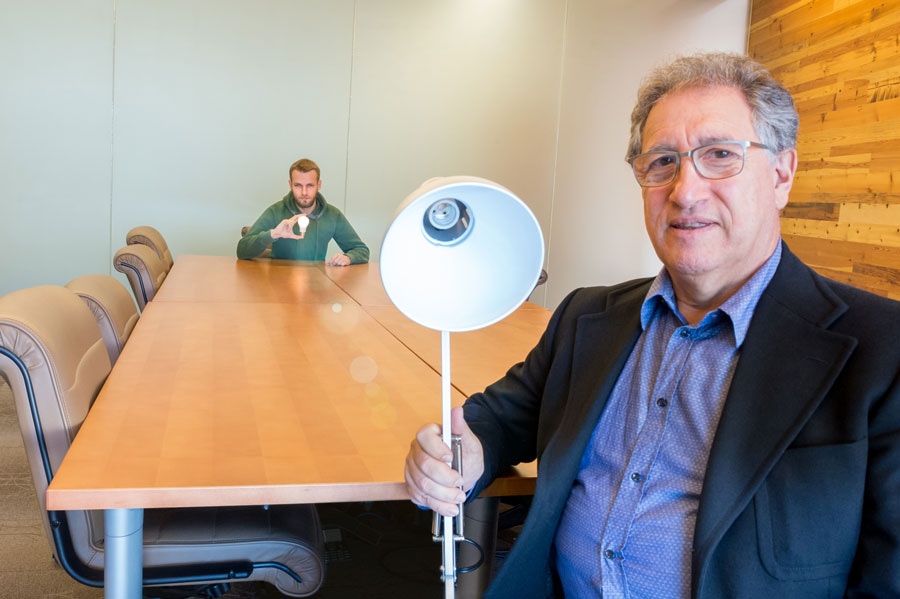Oct 21 2016
 Argonne scientists Ivan Sadovskyy (left) and Valerii Vinokur published a paper showing a mathematical construction to a possible local violation of the Second Law of the Thermodynamics. One implication for the research could be a way to one day remotely power a device — that is, the energy expended to light the lamp could take place anywhere. (Image by Mark Lopez/Argonne National Laboratory.)
Argonne scientists Ivan Sadovskyy (left) and Valerii Vinokur published a paper showing a mathematical construction to a possible local violation of the Second Law of the Thermodynamics. One implication for the research could be a way to one day remotely power a device — that is, the energy expended to light the lamp could take place anywhere. (Image by Mark Lopez/Argonne National Laboratory.)
The Second Law of Thermodynamics, which states that entropy always increases, is the most inviolable law for over a century and a half of physics. Chaos reigns supreme in this universe. Recently researchers at the U.S. Department of Energy's (DOE's) Argonne National Laboratory claimed that they have potentially found a small loophole in this well-known Second Law.
Their research findings have been published in Nature Scientific Reports, and illustrate a likely avenue to a scenario where the Second Law is violated on the microscopic level.
The Second Law is supported by what is known as the H-theorem, which states that if a door is open between two rooms, one cold and one hot, they will ultimately settle into lukewarm equilibrium; and the hot room will never become hotter.
However, even in the twentieth century with growing knowledge of quantum mechanics, researchers have not completely understood the basic physical origins of the H-theorem.
Recent progress in a field called quantum information theory provided a mathematical construction in which entropy grows.
What we did was formulate how these beautiful abstract mathematical theories could be connected to our crude reality.
Valerii Vinokur, Distinguished Fellow, Argonne National Laboratory
The researchers used the quantum information theory, which is based on abstract mathematical systems, and applied it to condensed matter physics, a well-researched field with several established experiments and laws.
"This allowed us to formulate the quantum H-theorem as it related to things that could be physically observed," said Ivan Sadovskyy, a joint appointee with Argonne's Materials Science Division and the Computation Institute and another author on the paper. "It establishes a connection between well-documented quantum physics processes and the theoretical quantum channels that make up quantum information theory."
The research predicts certain conditions under which the H-theorem could be broken and entropy - in the short term - might actually reduce.
In the year 1867, physicist James Clerk Maxwell had already reported a hypothetical way to break the Second Law: if a small theoretical being sat at the door between the cold and hot rooms and only let through particles moving at a specific speed. This theoretical imp is referred to as "Maxwell's demon."
Although the violation is only on the local scale, the implications are far-reaching. This provides us a platform for the practical realization of a quantum Maxwell's demon, which could make possible a local quantum perpetual motion machine.
Valerii Vinokur, Distinguished Fellow, Argonne National Laboratory
For instance, he stated, the principle could be incorporated into a "refrigerator" which could be cooled remotely - that is, the energy utilized to cool it could occur anywhere.
The researchers are hoping to work with a team of experimentalists to devise a proof-of-concept system.
The research paper, "H-theorem in quantum physics," was published September 12 in Nature Scientific Reports. Other authors on the study were G.B. Lesovik of Russia's L.D. Landau Institute for Theoretical Physics and Switzerland's Theoretische Physik; A.V. Lebedev of Theoretische Physik; and M.V. Suslov of the Moscow Institute of Physics and Technology.
The research was supported by the U.S. Department of Energy's Office of Science, the Swiss National Foundation, the Pauli Center for Theoretical Studies at ETH Zurich and the Russian Foundation for Basic Research.